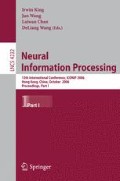Abstract
We present a computational model of neuron, called firing cell (FC), that is a compromise between biological plausibility and computational efficiency aimed to simulate spiketrain processing in a living neuronal tissue. FC covers such phenomena as attenuation of receptors for external stimuli, delay and decay of postsynaptic potentials, modification of internal weights due to propagation of postsynaptic potentials through the dendrite, modification of properties of the analog memory for each input due to a pattern of long-time synaptic potentiation (LTP), output-spike generation when the sum of all inputs exceeds a threshold, and refraction. We showed that, depending on the phase of input signals, FC’s output frequency demonstrate various types of behavior from regular to chaotic.
Access this chapter
Tax calculation will be finalised at checkout
Purchases are for personal use only
Preview
Unable to display preview. Download preview PDF.
References
Bialowas, J., Grzyb, B., Poszumski, P.: Firing Cell: An Artificial neuron with a simulation of Long-Term-Potentiation-Related Memory. In: The Eleventh International Symposium of Artificial Life and Robotics, Beppu, pp. 731–734 (2006)
Atwood, H.L., MacKay, W.A.: Essentials of Neurophysiology. B.C. Decker Inc., Toronto (1989)
Schmidt, R.F. (ed.): Fundamentals of Neurophysiology, pp. 64–92. Springer, Heidelberg (1976)
Muller, D., Joly, M., Lynch, G.: Contributions of quisqualate and NMDA receptors to the induction and expression of LTP. Science 242, 1694–1697 (1988)
Bliss, T.V.P., Collingridge, G.L.: Asynaptic model of memory: long-term potentiation in the hippocampus. Nature 361, 31–39 (1993)
Bekkers, J.M., Stevens, C.F.: Two different ways evolution makes neurons larger. In: Storm-Mathisen, J., Zimmer, J., Ottersen, O.P. (eds.) Progress in Brain Research, vol. 83, pp. 37–45. Elsevier, Amsterdam (1990)
Izhikevich, E.M.: Simple model of spiking neurons. IEEE Transactions on Neural Networks 14, 1569–1572 (2003)
Hines, M.: A program for simulation of nerve eqations with branching geometries. International Journal of Biomedical Comput. 24, 55–68 (1989)
Sikora, M.A., Gottesman, J., Miller, R.F.: A computational model of the ribbon synapse. Journal of Neuroscience Methods 145, 47–61 (2005)
Traub, R.D., Contreras, D., Cunningham, M.O., et al.: Single-Column Thalamocortical Network Model Exhibiting Gamma Oscillations, Sleep Spindles, and Epileptogenic Bursts. Journal of Neurophysiology 93, 2194–2232 (2005)
Bower, J.M., Beeman, D.: The Book of GENESIS: Exploring Realistic Neural Models with the GEneral NEural SImulation System (2003), http://www.genesissim.org/GENESIS/iBoG/iBoGpdf/index.html
Bliss, T.V.P., Lomo, T.J.: Long lasting potentiation of synaptic transmission in the dentate area of the anaestaetized rabbit following stimulation of the perforant path. J. Physiol. (London) 232, 331–356 (1973)
Rolls, E.T., Treves, A.: Neural Networks and Brain Function. Oxford University Press, Oxford (1998)
Amaral, D.G., Ishizuka, N.: Neurons, numbers and the hippocampal network. In: Storm-Mathisen, J., Zimmer, J., Ottersen, O.P. (eds.) Progress in Brain Research, vol. 83, pp. 1–12. Elsevier, Amsterdam (1990)
Mahovald, M., Douglas, R.: A silicon neuron. Nature 354, 515–518 (1991)
Elias, J.G., Northmore, D.P.M.: Building Silicon Nervous Systems with Dendritic Tree Neuromorphs. In: Maass, W., Bishop, C.M. (eds.) Pulsed Neural Networks, pp. 135–156. The MIT Press, Cambridge (1998)
Author information
Authors and Affiliations
Editor information
Editors and Affiliations
Rights and permissions
Copyright information
© 2006 Springer-Verlag Berlin Heidelberg
About this paper
Cite this paper
Grzyb, B., Bialowas, J. (2006). Modeling of LTP-Related Phenomena Using an Artificial Firing Cell. In: King, I., Wang, J., Chan, LW., Wang, D. (eds) Neural Information Processing. ICONIP 2006. Lecture Notes in Computer Science, vol 4232. Springer, Berlin, Heidelberg. https://doi.org/10.1007/11893028_11
Download citation
DOI: https://doi.org/10.1007/11893028_11
Publisher Name: Springer, Berlin, Heidelberg
Print ISBN: 978-3-540-46479-2
Online ISBN: 978-3-540-46480-8
eBook Packages: Computer ScienceComputer Science (R0)

